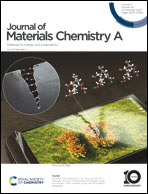Revealing insights into the axial coordination effect of M–N4 catalysts on electrocatalytic activity towards the oxygen reduction reaction†
Abstract
Axial coordination is a powerful strategy to effectively regulate the activity of M–N4 catalysts. However, the underlying mechanism is still not clear. Here, we explore the influence of axial coordination on the activity of Fe/Co/Ni-tetraphenylporphyrin covalent organic frameworks (Fe/Co/Ni-TPP COFs) towards the oxygen reduction reaction (ORR) using the DFT method. It is found that the widely used descriptors (e.g., d-band centers) are not applicable to explain the axial coordination effect on metal reactivity. The reason is that the hybridization of the dz2 orbital of metal centers and pz orbital of axial coordination atoms leads to the formation of new active orbitals, where the effect of the pz orbital should be considered in the design of the activity descriptor. Based on this, an activity descriptor using the total number of electrons in dz2 and pz orbitals is proposed. The results show that the reactivity of the metal center is enhanced by axial coordination if N(dz2) + N(pz) > 2, while it is reduced if N(dz2) + N(pz) ≤ 2. The application of the descriptor is further extended to explain the activity change of Fe/Co/Ni-TPP COFs by different types of axially coordinated atoms. This work provides new insights into the regulation mechanism of the axial coordination effect on metal reactivity.



 Please wait while we load your content...
Please wait while we load your content...